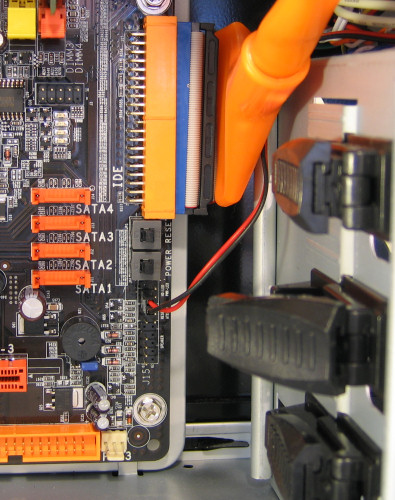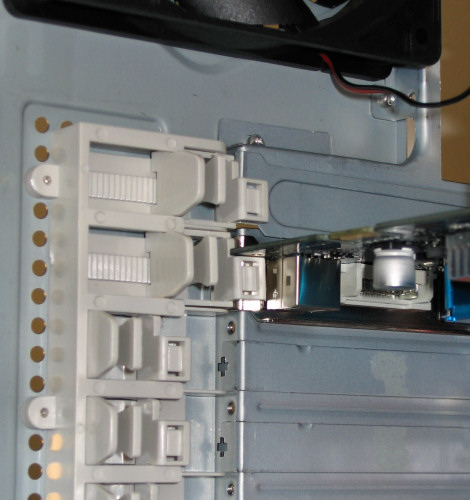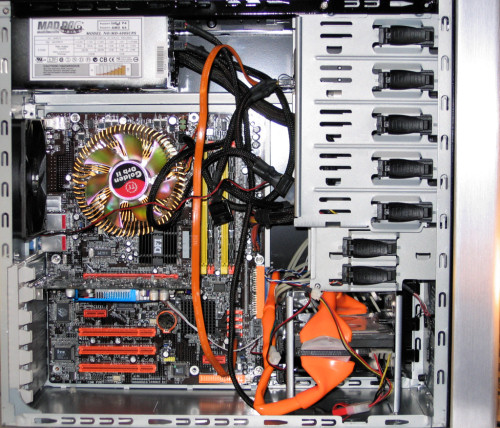Price-Point Comparing Three-Way Case Shootout
by Joshua Buss on January 13, 2006 12:05 AM EST- Posted in
- Cases/Cooling/PSUs
Raidmax X1 (cont’d)
For the first of our pictures of a system getting installed into the X1, we thought that we'd show how the X1 also suffers from the same problem as the P150 in terms of making it a little hard to get side-mounted IDE cables into the motherboard. Thankfully, the access from the other side of the case makes it a little easier than in the P150, however; and nowadays, SATA drives are becoming more and more popular as users everywhere share the frustrations with thick IDE cables.
Sliding the hard drive into place and locking it with the single locking clip was simple and effective, and after connecting together the components, our build was complete. This picture doesn’t really do any justice, but the X1 overall just has a very nice feel to it and was a pleasure to work in. We didn't find sharp edges in the chassis anywhere.
After putting the side panel back on and firing up the system, we were greeted with the X1's fanciest treat, which is a simple LCD on the front to display power, fan, and hard drive status as well as report a single temperature. Our efforts to do this unit justice were met with utter defeat, so we've borrowed this image from the RaidMax site to give you a better idea of what it really looks like. Just remember though that this picture comes from the white version of the case – on our case, the section to the right of the display is black.
For the first of our pictures of a system getting installed into the X1, we thought that we'd show how the X1 also suffers from the same problem as the P150 in terms of making it a little hard to get side-mounted IDE cables into the motherboard. Thankfully, the access from the other side of the case makes it a little easier than in the P150, however; and nowadays, SATA drives are becoming more and more popular as users everywhere share the frustrations with thick IDE cables.



Sliding the hard drive into place and locking it with the single locking clip was simple and effective, and after connecting together the components, our build was complete. This picture doesn’t really do any justice, but the X1 overall just has a very nice feel to it and was a pleasure to work in. We didn't find sharp edges in the chassis anywhere.
After putting the side panel back on and firing up the system, we were greeted with the X1's fanciest treat, which is a simple LCD on the front to display power, fan, and hard drive status as well as report a single temperature. Our efforts to do this unit justice were met with utter defeat, so we've borrowed this image from the RaidMax site to give you a better idea of what it really looks like. Just remember though that this picture comes from the white version of the case – on our case, the section to the right of the display is black.












69 Comments
View All Comments
Tamale - Friday, January 13, 2006 - link
Thanks for the quick criticism guys. Article updated.Please continue to scrutinize :)
Viditor - Friday, January 13, 2006 - link
Another comment for your conclusion (which is important for those of us that do video work)...the P150 is the only one of the 3 that has Firewire connector in front (as far as I can tell). If you could list the specs of each case at the head of that cases segment, that would also help (e.g. number of 3.5 slots, front firewire connector, etc...).Cheers!
ceefka - Saturday, January 14, 2006 - link
The P150 also features a cable organizer. If you take of the right panel, you'll see it at the right side of the internal 3,5" drive bays. This can make your cabling a lot tidier than the picture in the review shows.The FireWire connection is S400 on an Intel standard. Those who wish to connect AMD boards might want to call Antec for an adapter cable.
All'n'all I think the P150 looks like a fridge. I bought it though because it made the most sense for its price.
Tamale - Saturday, January 14, 2006 - link
I've heard the P180 referred to as a fridge much moreso than the P150.. hehebut yah, good catch on the cable organizer.
andrewln - Friday, January 13, 2006 - link
i wonder if they suspended the hard drive or they used the brackets.... it makes a difference when the hard drive seeksyacoub - Friday, January 13, 2006 - link
For that matter I wonder if they had the 3-speed 120mm fan it comes with on the lowest setting for the sound tests or still ramped up to max from the cooling tests.gman003 - Friday, January 13, 2006 - link
Why only 3 cases in the roundup? Not much to compare to... :-(In any case, I would really love to see an Aspire case tested against these sometime. I've been building with them for a while now and IMO they look better and cool better than Antec or other so called "Gaming" cases.
Raidmax and Antec cases are nice, but Raidmax is too chinsy with their materials at times and Antec is sooooo overpriced sometimes that one really shouldn't even consider them anymore as their go to case because of so many other competing vendors out there with high quality cases at cheaper prices.
mindless1 - Friday, January 13, 2006 - link
True, Antec is often overpriced but (putting aside the possible issues with the power supply), it's expected that with the Antec one has a power supply they can use long-term. Raidmax power supplies I wouldn't even install in most systems. What would be most interesting is a P150 discounted due to no power supply until the issues with the present one are resolved.oofboi754 - Thursday, March 31, 2022 - link
This case isn't so bad. Put in some Noctua Fans in the front and back ant it keeps my 3060ti (EVGA XC) and 12700kf (NH-U12S) at a comfortable 40 Degrees Celcius when idling. The Noctua Fans combines with the quiet nature of this case keep my rig silent as possible. For it's age, the cable managment isn't bad, it just takes a bit of creative thinking. This case is great for a Sleeper PC like I made.